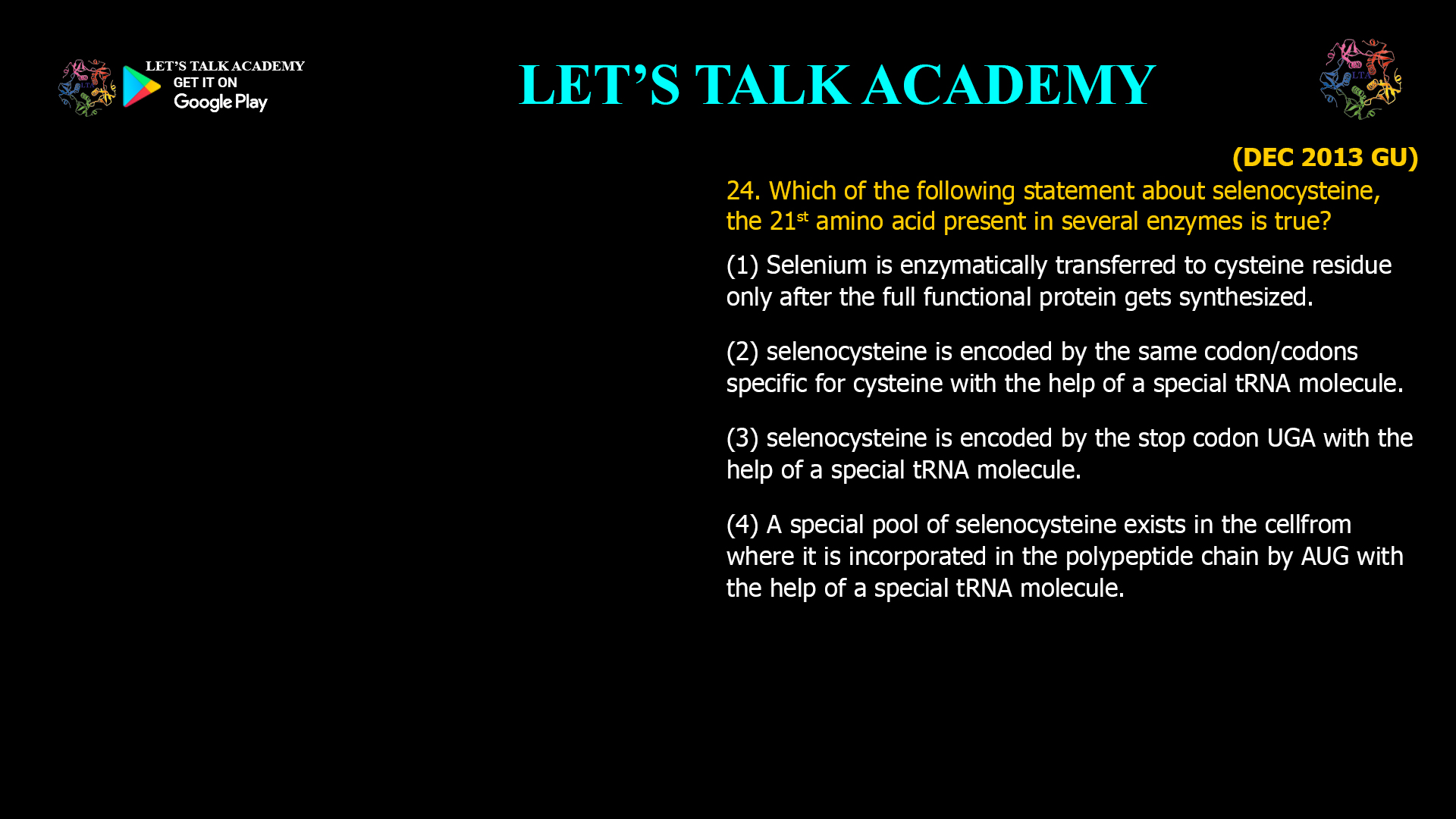- Which of the following statement about selenocysteine,the 21st amino acid present in several enzymes is true?
(1) Selenium is enzymatically transferred to cysteineresidue only after the full functional protein getssynthesized.
(2) selenocysteine is encoded by the samecodon/codons specific for cysteine with the help ofa special tRNA molecule.
(3) selenocysteine is encoded by the stop codon UGAwith the help of a special tRNA molecule.
(4) A special pool of selenocysteine exists in the cellfrom where it isincorporated in the polypeptidechain by AUG with the help of a special tRNAmolecule.Understanding Selenocysteine: The 21st Amino Acid and Its Unique Incorporation Mechanism
Selenocysteine (Sec) is often called the 21st amino acid because it is genetically encoded and incorporated into proteins during translation, but it differs significantly from the standard 20 amino acids. Its incorporation involves a specialized mechanism that recodes a stop codon and uses a unique tRNA and enzymatic pathway.
What Is Selenocysteine?
-
Selenocysteine is an amino acid containing selenium, an essential trace element.
-
Unlike other amino acids, Sec is not directly coded by a unique codon in the genetic code. Instead, it is incorporated at specific UGA codons, which normally signal stop.
-
The process requires special RNA elements and protein factors to recode UGA as a Sec codon.
How Is Selenocysteine Incorporated?
-
Charging of tRNA^Sec with Serine:
-
A specialized tRNA, called tRNA^[Ser]Sec, is first aminoacylated with serine by the normal seryl-tRNA synthetase (SerRS).
-
This tRNA is distinct from the standard tRNA^Ser and has unique structural features.
-
-
Conversion of Serine to Selenocysteine on tRNA:
-
The serine attached to tRNA^[Ser]Sec is enzymatically converted to selenocysteine by selenocysteine synthase (SelA in bacteria).
-
This conversion uses selenophosphate, synthesized by selenophosphate synthetase (SelD), as the selenium donor.
-
-
Recognition and Delivery to the Ribosome:
-
The Sec-tRNA^[Ser]Sec complex is delivered to the ribosome by a specialized elongation factor, SelB, which recognizes the selenocysteine insertion sequence (SECIS) element in the mRNA.
-
This allows the ribosome to interpret the UGA codon as a Sec codon rather than a stop signal.
-
Why Other Options Are Incorrect
-
Selenocysteine is not formed by post-translational modification of cysteine or serine residues in the protein (Options 1 and 2 are incorrect).
-
There is no free pool of selenocysteine in the cell due to its reactivity, so it is synthesized directly on its tRNA (Option 4 is incorrect).
-
Sec is encoded by the UGA stop codon, not by codons specific for cysteine (Option 3 is correct).
Summary Table
Option Description Correctness (1) Selenium transferred post-translationally to cysteine residues Incorrect (2) Post-translational modification of serine residues Incorrect (3) Selenocysteine encoded by UGA stop codon with help of special tRNA Correct (4) Special pool of Sec incorporated by AUG codon Incorrect
Keywords for SEO Optimization
-
Selenocysteine incorporation mechanism
-
21st amino acid Sec
-
UGA codon recoding
-
tRNA^[Ser]Sec charging and modification
-
Selenocysteine synthase SelA
-
Selenophosphate synthetase SelD
-
SECIS element and SelB elongation factor
-
Protein synthesis with selenocysteine
-
Molecular biology of selenoproteins
-
Selenium in protein biosynthesis
Conclusion
The true statement about selenocysteine is that it is encoded by the UGA stop codon with the help of a special tRNA molecule. This unique mechanism involves charging serine onto tRNA^[Ser]Sec, enzymatic conversion to selenocysteine, and targeted delivery to the ribosome, enabling the incorporation of Sec into selenoproteins during translation.
Correct answer: (3) selenocysteine is encoded by the stop codon UGA with the help of a special tRNA molecule.
-



